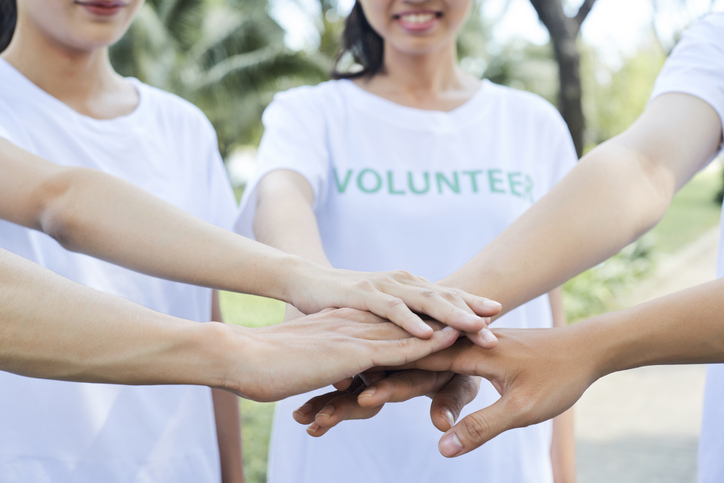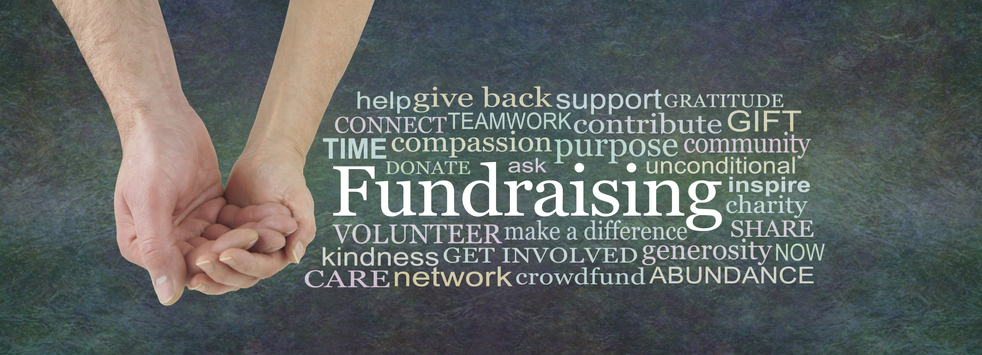
What exactly are nonprofits and how do they impact the communities they serve? Let’s start with the descriptions of nonprofits. According to Zippia, “Nonprofits are operations that provide accessible services for worthy causes, and they supply millions of jobs to Americans and represent a relatively huge portion of the United States GDP.” Let’s back up these statements with a few stats.
In the United States, there are 1.5 million nonprofit organizations that employ 10% of the U.S. workforce. Additionally, 5.7% of the United States GDP comes from nonprofits, with the total U.S. nonprofit annual revenue being $2.62 trillion. Those are some serious numbers! That’s exciting information about today’s nonprofits. But let’s go back in time a few hundred years and discover the history of nonprofits and fundraising in the United States.

The History of Nonprofits and Fundraising
Humans have been helping and giving back to each other since the beginning of time. But let’s focus on nonprofit organizations in the United States, which have a much shorter history. Let’s see what we can learn from history.
Just like today, when people in the past saw needs within their communities, they searched for solutions and ways to pay for them. Solutions take creativity. And solutions need fundraising. Here are some key dates in history when nonprofits made their impact and received the funding they needed to succeed.
The Early 1900s
In 1889, Andrew Carnegie’s Gospel of Wealth was released. It encouraged people to donate to causes. Many people found the YMCA to be a worthwhile cause to support. In the early 1900s, two of the YMCA’s most prominent leaders, Charles Sumner Ward and Frank L. Pierce, launched the first significant fundraising campaign that had never been seen before. In fact, this effort was known as the “YMCA School” of fundraising. Because of this, the YMCA grew from a private franchise to a large organization that big donors could support. So what’s the lesson to learn from this story? It doesn’t matter if your small nonprofit focuses on a niche cause, you can spread your fundraising campaigns nationwide.
The Late 1900s
The Civil Rights Movement showed us how Americans come together to tackle specific issues and causes. And during this time the U.S. government became more involved in social programs. In 1969, the Tax Reform Act gave us Section 501(c)3 in the Internal Revenue Service Code. This allowed organizations to legally have the status of charitable organizations. Additionally, they could offer tax exemptions to their donors. Of course, applications for 501(c)3 status grew, which in turn grew the government’s development of more rules, regulations, and policies.
In 1976, we saw a collaboration between the government and nonprofits. Congress passed a bill allowing nonprofits to spend up to $1 million per year on lobbying efforts. With this, the nonprofit voice was heard by the government. And by 1980, the nonprofit industry was influencing the business world by acting like businesses and taking risks.
The 2000s
Where would we be without the internet? It’s crazy to think that the World Wide Web has only been available to the public since 1991. This provided nonprofits with another channel to share their mission and reach supporters and donors. It’s critical for nonprofit organizations to ensure their websites are set up for online giving, that donors are provided with an easy giving experience, they know where their money is going, and the impact they are making.
We’re so fortunate to be living in this day and age where we can look back at the nonprofit trailblazers and remember how they’ve made a way. They tackled the challenges. They’ve done the troubleshooting. They created the roadmap.

Now, let’s discuss the impact nonprofits have in the U.S.
The Impact Of Nonprofits
Nonprofits symbolize the best of America. They provide an avenue for like-minded people to work together for a common cause and support the mission through donations and volunteerism. America’s 1.5 million nonprofits feed, heal, shelter, educate, inspire, enlighten, and nurture. Every day nonprofit organizations are strengthening communities.
How Every Person In The U.S. Benefits
It’s not too far-fetched to say that every person in the United States benefits from the work of nonprofits in one way or another. And they may not even realize it. It’s easy to see a nonprofit in action through feeding the hungry, providing rescue relief during weather disasters, adopting out animals in need, and much more. Let’s look at more ways that people and communities benefit from nonprofits.
According to the Council of Nonprofits, there’s a good chance you or a family member:
- Was born in a nonprofit hospital - nearly half of America’s hospitals are nonprofits.
- Avoided and/or escaped diseases because of scientific research by nonprofits.
- Attended religious services at one of the 350,000 nonprofit congregations.
- Learned how to swim through lessons or scouting camps at nonprofits.
- Developed life skills through youth development nonprofit organizations.
- Attended a nonprofit preschool, grade school, high school, college, or graduate school - and possibly with the support of a nonprofit scholarship fund.
- Exercised your rights to vote, to education, to travel, and other rights protected under the law that were secured and protected by nonprofits.
- Visited historic treasures and beautiful public lands preserved by nonprofits.
- Enjoyed family vacations at many nonprofit zoos and museums.
- Laughed, relaxed, rejoiced, and inspired at nonprofit arts performances.
Of course, that’s not a complete list of the numerous ways nonprofits improve lives. But you get a good idea! Now let’s look more into how nonprofits build healthy communities.
How Healthy Communities Are Built
Healthy communities are built and sustained through nonprofits that provide key services that contribute to economic stability and mobility. Nonprofit leaders are often engaged in local groups and politics to be the voice of the people they serve. Nonprofits typically develop strong community relationships and have keen insight into their communities' needs and the best ways to meet them. Strong, well-resourced nonprofits are critical for their communities to grow and provide opportunities.
However, nonprofit organizations are continually asked to do more with less. The Bridgespan Group conducted a survey of more than 200 nonprofits serving low- and middle-income communities. The nonprofits were asked to identify the top areas where they need the most help, which were:
- Fundraising (61%)
- Communications and marketing (51%)
- Program evaluation (38%)
- Performance management (33%)
- Technology (31%)
- Strategic planning (29%)
This shows that not only are donations critical to the success of a nonprofit but also networking and collaboration with businesses. These types of partnerships can identify opportunities, find solutions for challenges, and build services to help communities. But that’s a topic for another article. Let’s get back to a few more stats by The Aspen Institute:
- 92% of nonprofits are small and community-based, serving local needs.
- 92% spend less than $1 million annually.
- 88% spend less than $500,000.
- Nonprofits employ more than 10% of America’s private workforce.
- Less than 3% of nonprofits lobby to advance their missions.
So, where do nonprofit organizations get the funding they need to handle all of these responsibilities?
Nonprofit Funding Sources
Nonprofit organizations receive donations from a variety of sources, such as grants, corporate gifts, and major events. But in this section, we’re going to focus on individual cash and in-kind donations.
Individual Donations
Nonprofits rely on individuals who support their cause to contribute money, products, and/or services. Donors can choose to give one-time or recurring (monthly, quarterly, annual) donations. There are several types of channels that donors can give through including online platforms, direct mail, audio ads (radio, podcast), TV ads, or events. Also, some businesses provide a way for their employees to give through payroll deduction.
In-Kind Donations
In-kind donations include non-monetary gifts of goods or services such as office supplies, clothing, food, equipment, or professional services. Instead of money donations, nonprofits may be in need of in-kind donations at times. There are many benefits of in-kind donations for nonprofits including a reduction of their expenses, allowing better cash flow, and freeing up their resources for other activities. Benefits for donors include tax benefits, controlling where their money goes, and seeing the impact their goods and services have on the community.
No matter if donors prefer to give cash or in-kind donations, what they want most from nonprofits is full transparency. Donors want to know how their cash is going to be spent, how their donated goods will be used, how much of their donations are going directly to support the nonprofit’s mission, and the impact it’s making.
Even with nearly $3 trillion in revenue from donations, nonprofits still face challenges. Let’s dig more into some of them.
Challenges Nonprofits Face
Running a nonprofit organization isn’t all fun and games. Supporting a nonprofit’s mission is hard work. And they face common issues that every business faces, such as staying up to date with new technology, keeping current with regulatory requirements, ensuring financial stability, finding solutions to challenges with limited resources, and more. Let’s look at a few:
- Consistent Income. Relying on donors for a consistent income is hard for nonprofits. Donations can come and go at different levels and times throughout the year. Nonprofits must not only raise enough to cover program costs but also administrative costs. That’s why most nonprofits run with a small staff and lots of volunteers.
- Social Impact. Needless to say, there is less to go around in this unpredictable economy. So nonprofits have pressure to show they can do more with less and still meet their goals of positively impacting those they serve.
- Battle For Talent. Nonprofits need to attract and retain the right talent just like any other business. But there is real competition with other industries to win that talent over, often with limited resources.
- Increased Need. Many people are facing poverty and economic hardship. Nonprofits have increasing requests for services from their communities - the environment, school programs, housing, and more. You name it, they are asked for it.
All of these areas are influenced by the revenue the nonprofits earn. So now let’s consider ways to fundraise for nonprofits.

Why Fundraising Is So Important
Let’s look back just a few years to 2020. We faced the challenges of a global pandemic, business closures, employee layoffs, and more. Even through all of that, according to Nonprofit Source, Americans donated a record $471.44 billion to charities, which was a 5.1% increase from the year before. That spirit of giving helped nonprofits keep their budgets balanced, expand their causes, and continue to support their communities. It’s obvious that fundraising is critical to the success of nonprofits. Without generous donors and supporters, many nonprofits wouldn’t be able to exist and make an impact on their communities.
But fundraising makes a larger impact than just keeping the doors open to nonprofits. It creates a healthy organizational culture, helps supporters feel connected to their communities, and gives people a tangible way to support the causes they care about. Below, we've outlined a few ways that fundraising positively supports nonprofits.
Fundraising Sustains Nonprofits
Nearly all nonprofits rely on cash and in-kind donations to cover operational expenses, programs, and more. Donations are an investment to sustain a nonprofit’s cause and good work in the community. And, donors love to hear and see how their support positively impacts those the nonprofit serves.
Fundraising Increases Awareness
Fundraising is an efficient way to publicize a nonprofit and its cause. The more awareness people have about a nonprofit, the more likely they are to support the nonprofit. Supporters who are aware of and engaged in events and fundraising campaigns are more likely to donate their money and/or volunteer their time.
Fundraising Increases Volunteerism
Many nonprofits don’t have a large enough staff to get done everything that they need to. That’s where fundraising can help as a way to recruit a new set of volunteers. When people see how a nonprofit works to make a difference, they may be compelled to volunteer. Especially when a nonprofit can demonstrate how volunteer engagement makes an impact.
Fundraising Expands A Nonprofit’s Reach
Many nonprofits want to expand new programs, provide more resources, and serve more people. The needs are never-ending. By raising more money, goods, and services, nonprofits can grow and serve even more in their communities.
Next, let’s take a look at the people who give to nonprofits.
Which Generation Is Most Philanthropic?
Every generation lives through different events in history that tell their story. Those events - whether shared or not - give each generation a different perspective and experience that shapes what’s important to them. And charitable giving is one area that is influenced by those events.
Let’s look at some recent data by iDonate on which generation donates the most to nonprofits.
Matures: born before 1946
This group is also referred to as the Silent Generation or Traditionalists. Matures were born before or during World War II. They lived through economic prosperity in the 1950s. And many served in the Vietnam War. Research shows that Matures give the most out of all the generations - 88% of them - to local places of worship and social services. Why do they give more? Basically, they grew up during a time of war, so giving what they had was what they learned was important.
Baby Boomers: born 1946-1964
This group was born into economic growth but experienced a recession in the 1970s. They hold a similar view as Matures regarding hard work. But they weren’t able to give as much because of the recession. Although, 72% do give to charity - mostly local places of worship and social services.
Gen X: born 1965-1980
This generation saw a shift in how they viewed the economy, work-life balance, and how they take care of themselves. They got to see the increase of technology in both work and professional lives. Research shows that 59% give to charity.
Millennials: born 1981-1995
This group is also referred to as Gen Y. Currently, they don’t give as much to charity as the generations before them, but they are the generation with the highest population. So, their potential for giving should be included in fundraising strategies for the near future.
Gen Z: born after 1995
This group is also referred to as Post-Millennials. They are the youngest and lowest-giving generation since they are teenagers and young adults just entering the workforce. But 44% of Gen Zers do give to charity, and that number will increase as they become more financially set up for donating to charity.
What’s important to consider in this research is that “Millennials and Gen Z are the future for charitable giving.” And the items important to them are trust in an organization and their motivation to give to a cause or mission. Additionally, these two generations are online - that won’t change. So, it’s important for nonprofits to “optimize their online presence” and ensure they have transparency into how donations are handled, whether they are case or in-kind.
Most people understand what cash donations are - when a donor provides tangible cash or online transfers of funds to a nonprofit. So, let’s take a deeper dive into in-kind donations. What are they and why are they important?
What Are In-Kind Donations?
An in-kind donation is the transfer of goods or services. Examples of in-kind donations that can either be used by your nonprofit organization or given to those you serve include:
- Goods: computers, software, furniture, office equipment, clothing, food, school supplies, medical equipment, and cleaning supplies
- Services: meeting space, mail services, and administrative support
- Expertise: legal, tax, or business consulting; marketing, website development, and strategic planning
Businesses are a common source of in-kind donations, but individuals are starting to appreciate the opportunity to give goods because they can control what they give and see the impact. That’s why it’s important for nonprofits to provide fundraising that includes in-kind support.
The Importance Of In-Kind Product Donations
In-kind donations can, and should, be an important part of your nonprofit’s fundraising strategy, if appropriate. Basically, in-kind product donations provide the goods you need free of charge!
Of course, nonprofits appreciate any and all donations. But when there are challenging times during economic downturns, pandemics, and natural disasters, in-kind donations are especially helpful. For example, the pandemic of 2020 caused an economic crisis that challenged businesses, nonprofits, and individuals. Many people found it easier to give goods they already had on hand rather than cash, which was in short supply. The benefits realized include:
- Donors can give in-kind when money is challenging, which provides more flexibility.
- Donors can realize the impact of their in-kind donation.
- Nonprofits can use in-kind donations right away.
- Nonprofits can use their cash for other needs when they don’t have to purchase goods that have been donated in-kind.
The Negatives Of In-Kind Donations
How can there be a negative to products your donors give? You may receive some goods that you can’t use. Let’s give an example of an animal shelter.
Individuals may donate their old puppy crates, veterinary clinics may offer discounts for vaccines and animal exams, and another supporter may donate already-opened pet food. The crates and discounts are very useful, but the opened pet food is a health and safety violation for the shelter. Supporters are trying to give out of the goodness of their hearts, but not always are the in-kind donations useful.
With a structured in-kind giving program, you can avoid throwing away donations and appearing ungrateful. This is where OneEach Mindful Giving becomes a game-changer for your nonprofit and for your donors.
Your nonprofit can decide and select which donations are acceptable and most helpful to your organization. Then you can share those selections with your supporters, and they can choose the in-kind products they want to give from your list. They know they are making a difference by donating what your nonprofit needs, and they can see the impact right away.
Recording In-Kind Donations
Another reason to have a more controlled in-kind donation program is the recording and reporting. There are requirements for both donor tax deductions and accurately filing your nonprofit’s tax forms. Also, recording your acceptance of in-kind donations is an important part of the Generally Accepted Accounting Principles (GAAP).
If you don’t know who leaves in-kind donations at your door, it’s impossible to say, “thank you” and record for the tax reasons listed above. That’s why an in-kind donation platform is key. In-kind donations are tax-deductible for your donors and the IRS requires nonprofits to provide a written acknowledgment for their supporters to receive a tax deduction in exchange for their in-kind donations.
When you acknowledge in-kind donations, you’ll need to include the following information:
- The name of your nonprofit and your EIN.
- The date you received the in-kind donation.
- A description of the donation.
- A statement declaring that the supporter didn’t receive anything in exchange for their gift.
How can you do all of this if you don’t have a controlled platform to track in-kind donations? It’s a challenge!
The Importance Of Investing In A Fundraising Platform
Fundraising is vital for your nonprofit. If you're looking to invest in your in-kind fundraising efforts, OneEach Mindful Giving is the way to go. You can select the goods you need, track gifts, provide customized receipts, and securely store all donor information.
OneEach Mindful Giving helps you to easily reach out to your supporters for in-kind donations. The steps are simple:
- Set up your Stripe Account for payment processing
- Set up your Amazon Business Account and select the products you need
- OneEach builds your Mindful Giving page integrated with your website
- Start launching fundraising campaigns
Wrapping It Up
Your dedicated supporters want to help your nonprofit in the most beneficial way. And you can make it easy for them by showcasing exactly what you need and asking for those in-kind contributions.
Schedule a demo with our OneEach team today to learn how we can help you simplify in-kind product donations and maximize community impact.





